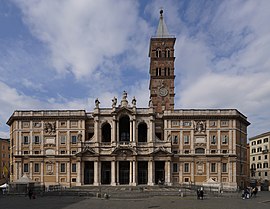
Back كنيسة سانتا ماريا ماجيوري Arabic Санта-Марыя-Маджорэ Byelorussian Санта Мария Маджоре Bulgarian Basílica de Santa Maria Major Catalan Санта-Мария-Маджоре CE Bazilika Panny Marie Sněžné Czech Santa Maria Maggiore Danish Santa Maria Maggiore German Σάντα Μαρία Ματζόρε Greek Baziliko Sankta Maria la Granda Esperanto
| Basilica di Santa Maria Maggiore | |
|---|---|
| Papal Basilica of Saint Mary Major | |
 Façade of the Basilica di Santa Maria Maggiore facing the Piazza | |
 Interactive map of Santa Maria Maggiore's location in Rome | |
| 41°53′51″N 12°29′55″E / 41.89750°N 12.49861°E | |
| Location | Rome |
| Country | Italy |
| Denomination | Catholic Church |
| Tradition | Latin Church |
| Website | Santa Maria Maggiore |
| History | |
| Status | Papal major basilica |
| Dedication | Blessed Virgin Mary |
| Cult(s) present | Salus Populi Romani |
| Relics held | |
| Architecture | |
| Architect(s) | Ferdinando Fuga |
| Architectural type | Basilica |
| Style | Roman architecture Romanesque architecture (tower) Baroque architecture |
| Groundbreaking | 432 |
| Completed | 1743 |
| Specifications | |
| Length | 92 meters (302 ft) |
| Width | 80 meters (260 ft) |
| Nave width | 30 meters (98 ft) |
| Height | 75 meters (246 ft) |
| Administration | |
| Diocese | Rome |
| Clergy | |
| Archpriest | Stanisław Ryłko |
| Official name | Historic Center of Rome, the Properties of the Holy See in that City Enjoying Extraterritorial Rights and San Paolo Fuori le Mura |
| Type | Cultural |
| Criteria | i, ii, iii, iv, vi |
| Designated | 1980[1] |
| Reference no. | 91 |
| Region | Europe and North America |
The Basilica of Saint Mary Major (Italian: Basilica di Santa Maria Maggiore, Italian pronunciation: [ˈsanta maˈriːa madˈdʒoːre]; Latin: Basilica Sanctae Mariae Maioris; Latin: Basilica Sanctae Mariae ad Nives),[a] or church of Santa Maria Maggiore (also referred to as Santa Maria delle Nevi from its Latin origin Sancta Maria ad Nives), is one of the four major papal basilicas as well as one of the Seven Pilgrim Churches of Rome and the largest Marian church in Rome, Italy. Santa Maria Maggiore is the first Marian sanctuary in the Western world and the mother of all sanctuaries.[2]
The basilica enshrines the venerated image of Salus Populi Romani, depicting the Blessed Virgin Mary as the health and protector of the Roman people, which was granted a Canonical coronation by Pope Gregory XVI on 15 August 1838 accompanied by his papal bull Cælestis Regina.
Pursuant to the Lateran Treaty of 1929 between the Holy See and Italy, the Basilica is in Italy and not the Vatican City.[3] However, the Holy See fully owns the basilica, and Italy is legally obligated to recognise its full ownership thereof[4] and to concede to it "the immunity granted by international law to the headquarters of the diplomatic agents of foreign states."[3] In other words, the complex of buildings has a status somewhat similar to an embassy.
- ^ "Historic Centre of Rome, the Properties of the Holy See in that City Enjoying Extraterritorial Rights and San Paolo Fuori le Mura". Whc.unesco.org. Archived from the original on 29 June 2011. Retrieved 17 June 2011.
- ^ "Un santuario che irradia la presenza di Maria" [A sanctuary that radiates the presence of Mary] (in Italian). L'Osservatore Romano. 5 August 2023.
- ^ a b Lateran Treaty of 1929, Article 15 ([1])
- ^ Lateran Treaty of 1929, Article 13 ([2])
Cite error: There are <ref group=lower-alpha> tags or {{efn}} templates on this page, but the references will not show without a {{reflist|group=lower-alpha}} template or {{notelist}} template (see the help page).